Key Takeaways: End-To-End Project Management
- The end-to-end project management process is broken down into six phases to help project managers deliver great results throughout a project’s lifecycle. The phases are initiation, planning, development, execution, monitoring and closure.
- The e2e process can help project leaders identify project risks, develop accurate budgets, enhance team collaboration and produce positive project outcomes.
- One of the downsides of end-to-end project management is that it is time-consuming. Be prepared to spend plenty of time creating meticulous plans and holding frequent team meetings.
Managing projects sounds easy; after all, how hard can it be to gather resources, assign a few tasks and set due dates? Very hard, actually. In fact, due to poor planning, the Denver International Airport project finished 16 months late and billions over budget. If you want your project to avoid a similar fate, you cannot miss our guide on end-to-end project management.
What is end-to-end project management, you ask? It’s a process that forces managers to plan for every part of a project, from the initiation phase to closure. In this guide, we’ll teach you about end-to-end project management by showing you what it is, how it works and how to implement it for your next project.
What is End-to-End Project Management? An Overview
End-to-end project management (e2e) is a process used to break down projects into smaller chunks. Small blocks of work are easier to plan and allow project managers and their teams to digest tasks and reach milestones more efficiently during a project’s lifecycle. This effective project management process makes defining, analyzing and managing project objectives easier.
The end-to-end process, which is used in traditional methodologies like PRINCE2, agile frameworks such as Kanban and Scrum, and hybrid methods that combine Waterfall and Agile traits, allows project managers to create detailed project scopes, keep on top of tasks and their due dates, and create accurate budgets throughout an entire project lifecycle.
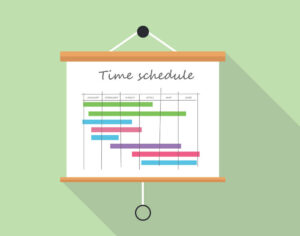
End-to-End Project Management Key Components
No matter which traditional project management methodologies or Agile frameworks you use, you’ll find that the end-to-end process is broken down into seven key components, which we’ll cover below.
- Scope Management — It’s the project manager’s responsibility to create a project’s scope (a detailed plan). The scope tries to prove project feasibility by defining goals, deadlines, milestones, budgets, and what’s needed to meet project stakeholder requirements.
- Cost Management — Includes estimating the project budget and determining the resources needed and how to control project expenses best.
- Risk Management — Involves identifying risks like miscommunication, staffing and project team issues and supply chain woes and putting plans in place to overcome the challenges during the project.
- Time Management — This component ensures that due dates for each task and timelines for each project management phase are created. Time management helps teams understand time constraints and will provide a global project timeline that can keep projects on track.
- Quality Management – Quality management refers to defining quality standards, implementing quality assurances and carrying out quality control checks on all project documentation and project deliverables.
- Stakeholder Management — The process of managing project stakeholders. Project managers must effectively communicate with stakeholders throughout the project life cycle to gain a better understanding of their expectations and concerns,
- Communication Management — Project managers must define communication methods between their teams, the client and stakeholders. For example, a manager could use some of the best project management software and their chat tools or platforms like Slack (here’s our Slack review).
End-to-End Project Management Lifecycle
Every end-to-end project you work on, regardless of the industry it is in, will have six key project management phases. The project phases will help you plan for every situation in the project management life cycle. We’ll cover each stage in more detail below.
- Initiation Phase — The phase in the e2e project management method where a project scope (a detailed project plan) is formed, and goals, budgets and overall project feasibility are discussed.
- Planning Phase — Goals, project aims, budget estimates, quality goals, potential timelines, risks and required resources are discussed during this phase.
- Development Phase — Plans and budgets are finalized, schedules and timelines are made, resources are acquired, and team meetings are held during this phase.
- Execution Phase — The project execution phase is where the team executes the plan and works towards the end goal.
- Monitoring Phase — During this phase, the project manager monitors team performance and ensures that challenges are overcome, deadlines are met and budgets aren’t destroyed.
- Closure & Delivery — The project closure phase is when the project is officially closed, the project deliverable is handed to the client and end-of-project meetings are held.

Initiation
- Introduce the project — A project manager must introduce the project to explain why it’s needed and how the company will benefit. The introduction is done by creating a project charter that defines the project, team roles and responsibilities, budget estimates and key stakeholders.
- Conduct research — Project managers should conduct research to help support their request. If a project charter can prove the project is feasible, approval will likely be given.
- Stakeholder identification — Stakeholders (individuals or companies) that will be affected by the project or who will be involved must be identified so that their needs and requirements can be taken into account.
- Hold a kickoff meeting — Once approved, the project manager holds a kickoff meeting with their team and stakeholders. The team discusses team structure (check out our guide to organizational structures), what must be accomplished, and project timelines.
Planning
- Problem identification — During the planning phase, teams must identify the key problem their project will solve. When the team has identified the problem, they can create a plan to help reach their goal.
- Create a timeline — Once the scope has been determined and milestones and tasks have been assigned, the project manager can plot the project’s timeline on a Gantt chart. A Gantt chart provides a global overview of tasks and is easy to maintain and read.
- Estimate the budget — Project leaders must estimate the project’s overall cost. Project managers can use activity-based costing to estimate how much each phase, task and resource will cost.
- Plan for risks — Every project has risks. Project managers need to plan for staffing issues, resource and material problems, budget constraints and more. By planning for potential issues upfront, project managers and Scrum Masters can overcome problems quickly when they arise.
- Discuss product quality — To know what’s expected from a quality standpoint, the project manager must understand what the client and stakeholders are looking for so that a quality assurance plan can be created.
- Identify required resources — Project managers must identify what resources they will need to complete the project. Managers must determine what’s needed from a human resource management perspective and, if required, a materials standpoint.
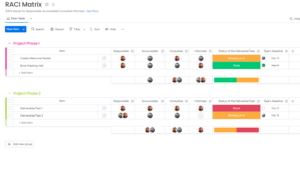
Development
- Set deadlines and budgets — During the development phase, the manager, client and stakeholders finalize all project deadlines and timelines and set the project’s budget.
- Gather required resources — Project managers must gather all needed supplies and materials. Resources like team members, software (be sure to check out our roundup of the best free project management software), and tools to complete the work must be acquired, too.
- Manage the team — Management should meet with project team members to ensure that everyone understands their role and what’s expected of them. Management should also ensure that everyone understands the project, project tasks, and potential risks.
Execution
- Manage the project — Leaders need to ensure team members are doing what they’re supposed to, that deadlines are met and that requests for help are handled. Leaders can utilize dashboards and reports in project management software to track the project’s progress and monitor time spent on tasks.
- Watch the budget — The budget must be watched constantly, as even slight changes to the plan can wreak havoc. Make sure that plan changes are discussed and fit within the budget. If this doesn’t happen, the project could experience scope creep.
- Implement risk strategies — If you encounter any of the risks discussed during the planning stage, use the risk plan to overcome them. If any issue not discussed pops up, meet with your team, the client and stakeholders to find a solution.
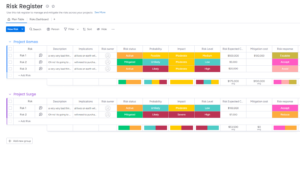
Monitoring
- Ensure product quality — Throughout the project, management should review their team’s work and check the quality of the product. They should also test and evaluate the product frequently so that potential issues can be identified and fixed promptly.
- Evaluate team output — If a task takes too long to complete, it’s time to find out why. Does the person assigned to the job need more training? Look to see if there are supply issues or if more people need to be assigned to the task. To ensure the project is delivered on time, you must make sure the team is performing to its maximum potential.
- Team collaboration and stakeholder interaction — Agile methodologies, like Scrum and hybrid methodologies — traditional methods that embrace agile principles — encourage daily team meetings and bi-weekly review meetings with the client and stakeholders. This helps keep everyone updated by maintaining open lines of communication.
Closure & Delivery
- Close the project — Closing the project is the final stage. The manager must ensure that every task is finished and all client and stakeholder objectives have been met. The manager then hands over the project deliverable and writes a closing report before officially closing the project.
- Review the project — Once the project has ended, the project manager should hold a retrospective meeting to discuss project performance. These meetings allow the team to reflect on the project, discuss wins and losses, create new methods to improve future projects, hold team-building exercises and celebrate.
- Release your resources — Once the retrospective meeting is complete, the project manager releases the team. Individuals can then be assigned to new projects within the organization or released.
Advantages & Pitfalls of End-To-End Project Management
While the end-to-end project management method has many advantages, you must also know the disadvantages. We’ll cover the pros and cons below.
End-To-End Project Management Advantages
- Better results — Having a robust plan and sticking to it will produce better results than trying to run a project without any direction or forethought.
- Increased client and stakeholder satisfaction — A better outcome will please clients and stakeholders. It will also enhance the chances of being hired by them again.
- Improved risk management — Recognizing potential risks and weak spots in a project before it starts can help managers deal with issues efficiently if they occur during the project.
- Team collaboration — The end-to-end process encourages open communication and collaboration. Frequent meetings with transparent communication can help build trust and improve decision-making.
- Controlled budgets — Using activity-based costing methods to estimate a project’s budget and implementing measures to control new initiatives and tasks will help a project finish on or under budget.
End-To-End Project Management Pitfalls to Avoid
- Be prepared — The process of planning an end-to-end project can be time-consuming and can delay a project if a project manager is unprepared or unsure of the steps.
- Underplanning — Underplanning for a project can lead to delays, low-quality deliverables and scope creep. Take the time to meticulously plan for every variable.
- Skipping team meetings — Falling behind schedule is never a good thing, but cutting corners is worse. If you fail to hold regular team meetings where leaders can share project information and solutions to problems, you could find yourself in deep water.
Best End-To-End Project Management Software
We have reviewed many project management tools that support the end-to-end project management process. Below are our expert’s five favorite platforms.
- monday.com — An all-in-one project management tool that supports many working styles and integrations and offers some of the most affordable paid plans. Find out more in our monday.com pricing guide.
- ClickUp — A do-it-all platform with robust task management tools, powerful collaboration features and a great free plan. Check out our ClickUp review.
- Asana — Another all-in-one platform with a beautiful interface, powerful task and resource management tools and a loaded free plan. Here’s our Asana review.
- Jira — Hands down the best project software for software developers and Scrum teams thanks to intuitive Kanban boards and easy-to-use backlogs. Here’s our Jira review.
- Leantime – Easy-to-use task management tools, affordable plans, and tools for business analysis, project briefs, retrospective meetings and risk management. Find out more in our Leantime review.
How to Manage a Project From Start to Finish With monday.com
Now that you know what goes into end-to-end project management, we’ll show you how one of our favorite project management platforms, monday.com (here’s our monday.com review), can help you plan and organize a project, manage tasks, communicate with team members and stakeholders and help you deliver your project on time.
1. Create a Project Charter
A project manager must create a project charter or scope. Creating a basic project plan is easy on monday.com, as they offer a template to help get you started. To complete it, you fill in the blank fields, which include defining project objectives, performance metrics, cost analysis, team members and stakeholders and more.
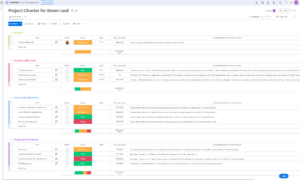
will benefit from the project will help you gain approval.
The template auto-calculates cost estimates once you enter projected totals for each category. Once completed, the plan can be handed to executives who will deny or green-light the project. Once approved, you can hold a kick-off meeting with the stakeholders and your project team.
2. Create a RACI Chart and Assign Roles and Responsibilities
A RACI chart is an easy-to-read tool that gives a visual representation of your team and what they are responsible for. You can download a RACI chart template for monday.com that makes creating one straightforward.
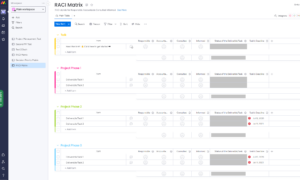
To create your chart, you enter the job roles your project needs, and you create columns entitled Responsible, Accountable, Consulted and Informed. Next, you enter a list of responsibilities. You then assign staff members as responsible, accountable, consulted and informed for each role and task.
Not only does this chart show who is responsible for a specific job, but it also shows who they report to (accountable), another subject matter expert who can give advice (consulted) and who needs to be kept in the loop, such as a stakeholder (informed). You can learn more about RACI charts in our RACI chart guide.
3. Plot Your Project Timeline in a Gantt Chart
Another essential step in the planning phase is creating a project timeline. The best way to do this is with a Gantt chart. To create a project timeline, you’ll need to enter project milestones (a specific point or event in a project) and every task that needs to be completed to reach those milestones and finish the project overall.
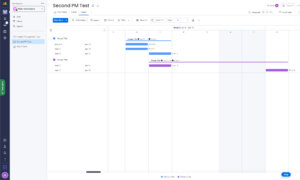
When you create tasks on monday.com (or most other project management platforms), you can enter the task and a description of what needs to be done. You can assign start and due dates and set the task status. Managers can also upload files that support the job and leave comments for the designated team member.
After all task information has been entered, the tasks will appear on the Gantt chart. You’ll then have a visual representation of each task that shows when it’s due and when you need to hit each milestone in your project.
4. Assign Tasks to Team Members
Now that you have created every task for the project, it’s time to assign team members to the tasks. To assign a job, go to the Kanban view and click on the task that needs to be assigned. Once you do this, a task card panel will appear. On monday.com, all you need to do is click person and then select the correct team member from the drop-down menu.
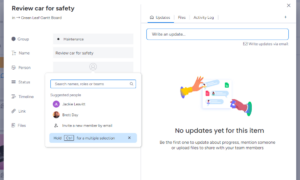
team members to all of the created tasks.
5. Monitor Project Progress With Dashboards and Reports
Once your project is underway, you must keep track of your team members, budgets, and due dates. One of the most efficient ways to do this is with dashboards that can display multiple project metrics in one place.
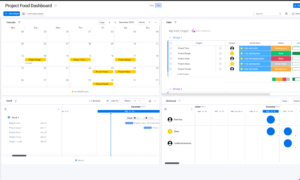
Dashboards are highly customizable. The dashboard on monday.com can display multiple widgets that can show task information, updates for individual team members and your project timeline. You can also display budget information, time spent on tasks, workloads, and more. Be sure to set up dashboards so you can have quick access to critical information.
6. Ensure Team Communication and Collaboration
It’s crucial to remain in contact with your team throughout the life cycle of the project. There are many ways to achieve this. On monday.com, you can leave comments on task cards. You can also use integrations to connect to chat apps like Slack, Zoom and Google Chat. No matter which method you choose, you must be in constant contact with your team.
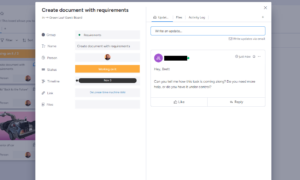
the task cards in your project management software.
7. Close the Project
The final phase of the end-to-end management method is closing the project. Project managers must ensure that every task associated with the project is complete and that any late change requests from stakeholders and the client have been met.

Once all tasks have been signed off, the project leader should hold a retrospective meeting with the team so that they can discuss wins and losses and receive feedback about their work. At the end of this meeting, the project manager also thanks and releases the team to work on other projects.
Final Thoughts
The end-to-end project management method might not be for everyone, but as we have shown, the process does have some clear benefits. The e2e project management process can be time-consuming. Still, it can help leaders develop a comprehensive project plan, meet project goals, come in under budget, build a team that trusts each other and deliver project success.
Have you managed a project that has used the end-to-end project planning method? What project framework did you use with it, traditional or agile? Did you encounter any problems? Let us know in the comment section, and as always, thanks for reading.
FAQ: End-to-End Project Management
-
End-to-end project management is a process that breaks down projects into smaller, more manageable components.
-
There are six phases of end-to-end project management: initiation, planning, development, execution, monitoring and closure and delivery.
The post End-to-End Project Management Guide in 2023: Components, Phases & Tools appeared first on Cloudwards.

